Products
-
-
Raw billets, beam billets, and plate billets are lifted using electric lifting magnets.
-
Specialized Lifting Electromagnet for High-Speed Wire (Coil)
-
Pipe blanks, steel pipes, large round blanks for lifting with electric lifting magnets
-
Heavy rail, steel pipe lifting with electric lifting magnets
-
Medium-thick steel plate lifting with electric lifting magnet
-
Medium-thick steel plate multi-sheet lifting special lifting electromagnet
RELATED INFORMATION
Electric Furnace Ingredient Weighing and Monitoring System
Classification:
E-mail:hnyysg0730@163.com
Case Details
System Composition and Function Description
System Composition
The electric furnace charging and weighing monitoring system series consists of the following parts: wireless microcomputer electromagnetic batching system, electric furnace charging vehicle dust removal system, electric furnace charging and batching upper computer management monitoring system, etc. It can also integrate information from the molten iron spectrum analysis system, molten iron temperature detection system, alloy spectrum analysis system, electric furnace molten iron weighing system, and batching crane automatic control system for display on industrial large screens.

The system can achieve complete automation of electric furnace smelting, charging, weighing, and monitoring management once connected. A typical complete system block diagram is as follows: general customers can preferentially choose: wireless microcomputer electromagnetic batching system, high-temperature hook scale, vibrating charging vehicle system, dust removal system, electric furnace charging and batching upper computer management monitoring system, etc. The electric furnace charging and batching upper computer management monitoring system forms a wireless local area network with each set of electric furnace crane microcomputer automatic batching systems.
1. Electromagnetic Charging Vehicle System
This system mainly consists of three major systems: vibrating charging vehicle system, electromagnetic batching control and monitoring management system.
(1) Charging Vehicle System:
It consists of a vibrating charging vehicle, an electric control cabinet, and a horizontal ground cable reel.
(1) Charging vehicle and electric furnace layout method
Method A:Longitudinal moving charging method (ZDLC-A):
Each electric furnace is equipped with a charging vehicle, which moves longitudinally for charging, and each electric furnace charging operates independently: the advantages are independence, reliability, and high charging efficiency, allowing multiple furnaces to start simultaneously without affecting each other, and can also serve as backups: the disadvantage is that the initial investment for multiple charging vehicles is relatively high.
Method B:Transverse moving charging method (ZDLC-B):
The charging vehicle moves transversely and can charge two or more furnaces; the investment for one vehicle is only half of the longitudinal method, but the disadvantage is that if the charging vehicle fails, it cannot charge the furnace; and it is necessary to consider that the charging vehicle's discharge port does not conflict with the furnace cover position.
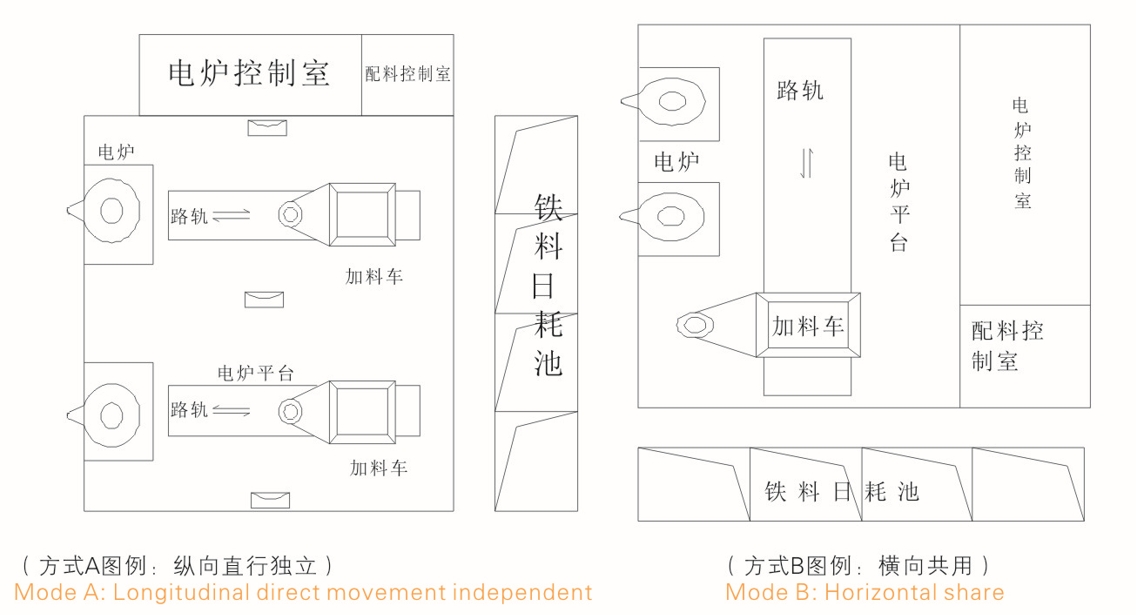
Method C: Longitudinal and transverse dual-direction moving charging method (ZDLC-C):
There are both longitudinal and transverse tracks, allowing the charging vehicle to move both longitudinally and transversely to charge parallel electric furnaces. Two or more electric furnaces can share one charging vehicle, which reduces investment (multi-use), but the disadvantage is that the dual-direction operation mechanism and vehicle structure are complex, resulting in higher manufacturing costs, and the longitudinal track is higher than the platform, making movement inconvenient and maintenance more troublesome. This method is rarely used unless there are obstacles (such as columns) between electric furnaces.
Method D:Longitudinal moving rotating charging method (ZDLC-D):
The charging vehicle first moves longitudinally to the middle position between two furnaces, and the vibrating charging trough on the vehicle can rotate, allowing it to charge both electric furnaces. Two electric furnaces share one charging vehicle; this is more economical, but the rotating method of the vehicle leads to a complex structure, higher failure rate, and troublesome maintenance, so it is rarely adopted.


(2) Considerations for the layout of vibrating charging vehicles and electric furnaces:
A. Regardless of the charging vehicle layout method, it is necessary to consider that the discharge port of the charging vehicle does not conflict with the position of the electric furnace cover and does not interfere with the electric furnace environmental dust removal system; it can also be considered comprehensively for coordinated design.
B. The position of the iron material daily consumption pool should be as close as possible to the charging vehicle's waiting position during electromagnetic disk batching. It should be avoided that the electromagnetic disk lifts the material from above the platform or the electric furnace operation area to prevent iron material from falling and causing personal and property damage!
C. Design considerations:
When designing the charging vehicle, users need to provide relevant dimensions as shown in Figure 1 (A~F) and provide the position of the electric furnace cover; the supporting structure of the electric furnace platform and the foundation must consider the weight of the charging vehicle when fully loaded or the weight of the charging barrel, the vibration force, and the position of the tracks. The material pool, charging method, conveying, and charging vehicle layout must be scientifically reasonable.
(3) Explanation of vibrating charging vehicle selection:
a) Table (1) shows the one-to-one electric furnace charging vehicle method, and other one-to-two methods can refer to the selection; the matching rule between the electric furnace and the charging vehicle is: generally, each furnace is equipped with two units for batching, and the charging vehicle specification is usually selected based on 60% of the electric furnace melting rate. For example, a 5T electric furnace is best matched with a 3T charging vehicle; if each furnace is equipped with one unit for batching, then the charging vehicle specification should match the electric furnace melting rate, such as a 5T electric furnace with a 5T charging vehicle. Under the premise of ensuring the batching and charging speed, it is generally advisable to select a smaller model of the charging vehicle, which not only requires less investment but also has a lighter vehicle body and less vibration, thus lowering the load requirements on the electric furnace platform.
b) Explanation of the charging vehicle model: The model consists of three parts: ZDLC-囗A/B/C/D(-BP), where ZDLC indicates the vibrating charging vehicle, the number represents the rated bulk density of the metal charge for each vehicle (in tons). Type A is for longitudinal straight movement, Type B is for transverse movement, Type C is for dual-direction movement (longitudinal and transverse), and Type D is for straight movement with rotation. If a variable frequency drive is used, add "-BP" at the end.
(4) Vibrating charging vehicle and electric control matching table--as follows:

Charging Vehicle Electric Control System:
Using Siemens electrical equipment, with complete motor protection measures to ensure reliable and stable operation of the vehicle: start and stop use regenerative and energy-saving braking to ensure smooth stopping; power supply and signal control cables use elastic cable reels, and there are also low-voltage power supply methods using track: in some cases, variable frequency drive control can be selected, with better performance in driving, vibration, operation, feeding, and stopping! Generally, each charging vehicle is equipped with an electric control box for operation, which can also be fixedly installed outside the vehicle; the vehicle is equipped with mobile sound and light warning signals to ensure safety for people and vehicles.
Charging Central Control System:
Using Siemens PLC as the control core, it can control the longitudinal (or transverse) movement and transportation of 2 to 4 charging vehicles, feeding vibration, etc., with manual, semi-automatic, and fully automatic control operations, position detection, action interlocking, and can be linked with the electric furnace cover lifting mechanism, furnace chamber material level detection, and smoke dust removal environmental protection facilities: all position signals use Siemens technology proximity switches for detection.
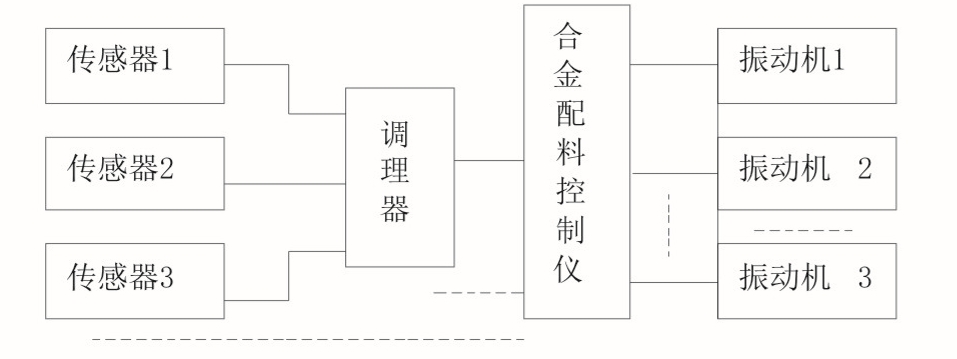
2. Block Diagram of Electric Furnace Charging Weighing and Monitoring System

Electric furnace with raw material management and monitoring wireless local area network system, vibration feeding vehicle system, and removal system based on user site needs, specific configuration selection.
(1) Electric furnace raw material weighing system
A. System Overview
Using electromagnetic disks to absorb materials, the microcomputer automatically controls the disk's suction based on the pre-input metal charge formula, automatically and accurately accumulates materials, compensates automatically within each furnace, alarms for deviations, and automatically stores and prints records of various material parameters; static accuracy up to 1%, dynamic material accuracy up to 2%: fast material feeding speed, each feeding takes 12~18 seconds, each unit feeding time 6~8 minutes, each furnace feeding time 12~16 minutes, can store 12 common material lists, each unit (batch) can simultaneously feed 5 types of materials (such as pig iron, return materials, scrap steel, etc.): can simultaneously feed 1~3 electric furnaces with different formulas alternately: the system uses an industrial-grade computer control system as the control core, with watchdog, power failure protection, and other monitoring measures to ensure high reliability of the system: has a standard 485/232 interface for communication with the upper computer: products are available in eight specifications suitable for 0.5T~15T electric furnaces.
B. Microcomputer Electromagnetic Material Feeding Process:
Input formula --> absorb materials --> lift --> feed materials --> ready (deviation alarm) -> discharge into the material vehicle or hopper (re-absorb and feed) --> continue to feed the next material until this type of material is finished -> continue to feed the next type of material --> until all materials in this unit are completely fed --> Enter the feeding process, refer to the right cabinet

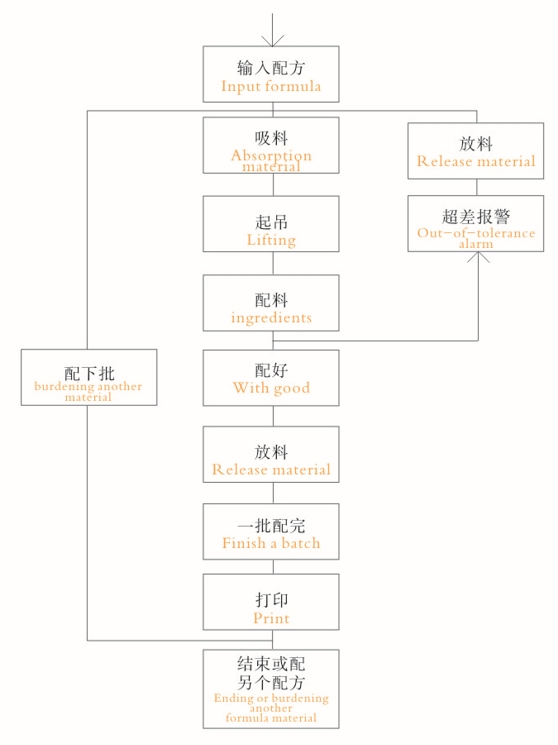
A. Wireless hook sensor: specially designed, impact-resistant, sealed, dustproof, waterproof, and anti-magnetic design, can adapt to the frequent impacts during electromagnetic disk iron feeding, stable data wireless transmission, equipped with two rechargeable sealed batteries, one for use and one for backup (charging), battery usage time can reach 40~70 hours (about a week), antenna reinforced protection, equipped with a special small cart for transportation.
Each set of wireless data transmission microcomputer iron feeding instrument consists of two parts: wireless data transmission hook sensor, wireless microcomputer iron feeding control instrument; technical parameters and function analysis are as follows:
1. Wireless data transmission hook-type weighing sensor (LN series)
2. Normal temperature type wireless data transmission hook-type weighing sensor
3. Range: (rate capacity): 1t, 2t, 3t, 5t, 10t
4. Features:
1) Accurate measurement, display division value can be set as needed; accuracy level meets international standard for electronic scales.
2) All-steel structure shell, impact-resistant, anti-electromagnetic interference 3) Set weighing digital display circuit, using 256*64 dot matrix LCD Chinese display screen, unique human-computer interaction function, rich data management and Chinese printing, built-in perpetual calendar clock, self-contained signal strength power condition monitoring system, wireless data transmission distance greater than 100m without obstruction. 4) Uses 8 frequency points in the internationally common 433MHZ frequency band to achieve wireless communication; 5) Utilizes high-speed ND conversion, digital filtering, nonlinear compensation, automatic zero tracking, and other technologies: improves the system's anti-interference ability and accuracy, eliminates zero drift.
6) The sensor scale body is powered by a large-capacity 6V/10Ah sealed lead-acid battery, with another spare one for alternating use, ensuring work and charging do not interfere: 7) Working temperature can be customized according to user requirements for normal temperature type: -15~55℃, heat-resistant type: normal temperature~180℃; 8) Equipped with RS232[485] interface, can communicate with upper computer and other devices. 9) Uses industrial-grade components and parts, dustproof, shockproof, and anti-mildew corrosion design, high reliability, and durability. Products include WPT-500W, 1000W, 2000W, 5000W, a total of four models.
B. Wireless microcomputer iron feeding control instrument: LCD large screen display, Chinese menu display operation, backlight, digital zero adjustment, full digital calibration, code management, hook sensor battery low voltage indication alarm; feeding control parameters can be adjusted by users according to actual conditions; wireless data transmission and remote control distance can reach 100m, with eight frequency points available; automatic precise accumulation of materials, automatic compensation within each furnace, automatic alarm for deviations, automatic storage and printing of various feeding parameters (feeding time, batch, actual weight, cumulative weight, melting speed, and melting rate); static accuracy up to 0.1%, dynamic material accuracy up to 2%: fast feeding speed, average feeding time of 12~16 seconds, feeding failure alarm rate as low as 5%, each unit feeding time 6~8 minutes, each furnace feeding time 12~16 minutes: can store 8 common material lists, each unit (batch) can simultaneously feed 5 types of materials (pig iron, return materials, scrap steel, etc.): can simultaneously feed 1~3 electric furnaces with different formulas alternately: uses an industrial-grade computer control system as the control core, with watchdog, power failure protection, and other monitoring measures to ensure high reliability of the system: has a standard 485/232 interface for two-way communication with the upper computer to receive formulas and send feeding data. This feeding instrument is available in desktop (with built-in printer) and wall-mounted (external printer) types, the wall-mounted type can be installed above the crane for remote operation.
C. Wireless remote control rectifier control equipment:
The main circuit uses fully controlled intelligent module conversion, with comprehensive protection measures from high-energy varistors, large-capacity rectifier transformers for isolation, Siemens technology electronic voltage control board control (with computer interface), feeding voltage (0~400V) continuously adjustable, with various feeding function indicator diagrams.

D. Digital electromagnetic feeding system:
This system uses a disk electronic scale to display the weight of the charge, manual magnetic feeding, and can print the feeding weight, with high static accuracy, making it an economical choice for customers; however, due to human factors, the feeding accuracy is relatively poor.
It also has both wired and wireless types, and the wireless products from ShenGang Company have completely solved the problem of frequent signal line disconnections, making it an economical product in the current market!
The manual magnetic feeding process is: absorb materials lift -- read data -- manually adjust magnetic feeding -- ready -- go to unload -- (print actual weight for this time) -- go to feed next time or next type of material -- repeat this process.
Wireless digital electromagnetic iron feeding scale (Y57AW/Y series) -- manual magnetic feeding, one set can feed 1~2 electric furnaces.
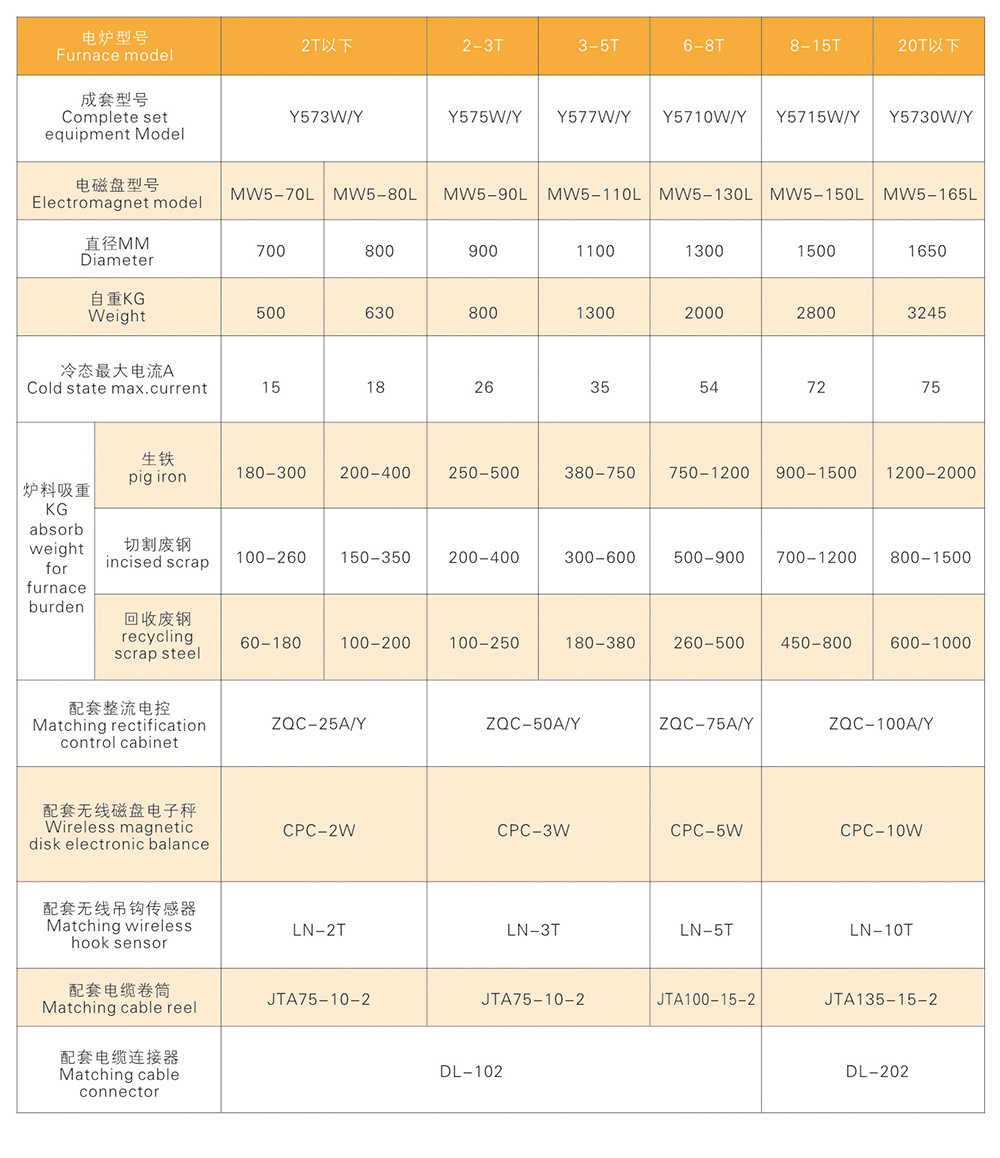
Wireless microcomputer electromagnetic automatic feeding system
(Y57W/series, Y-remote control) -- automatic feeding, one set can feed 1~2 electric furnaces.
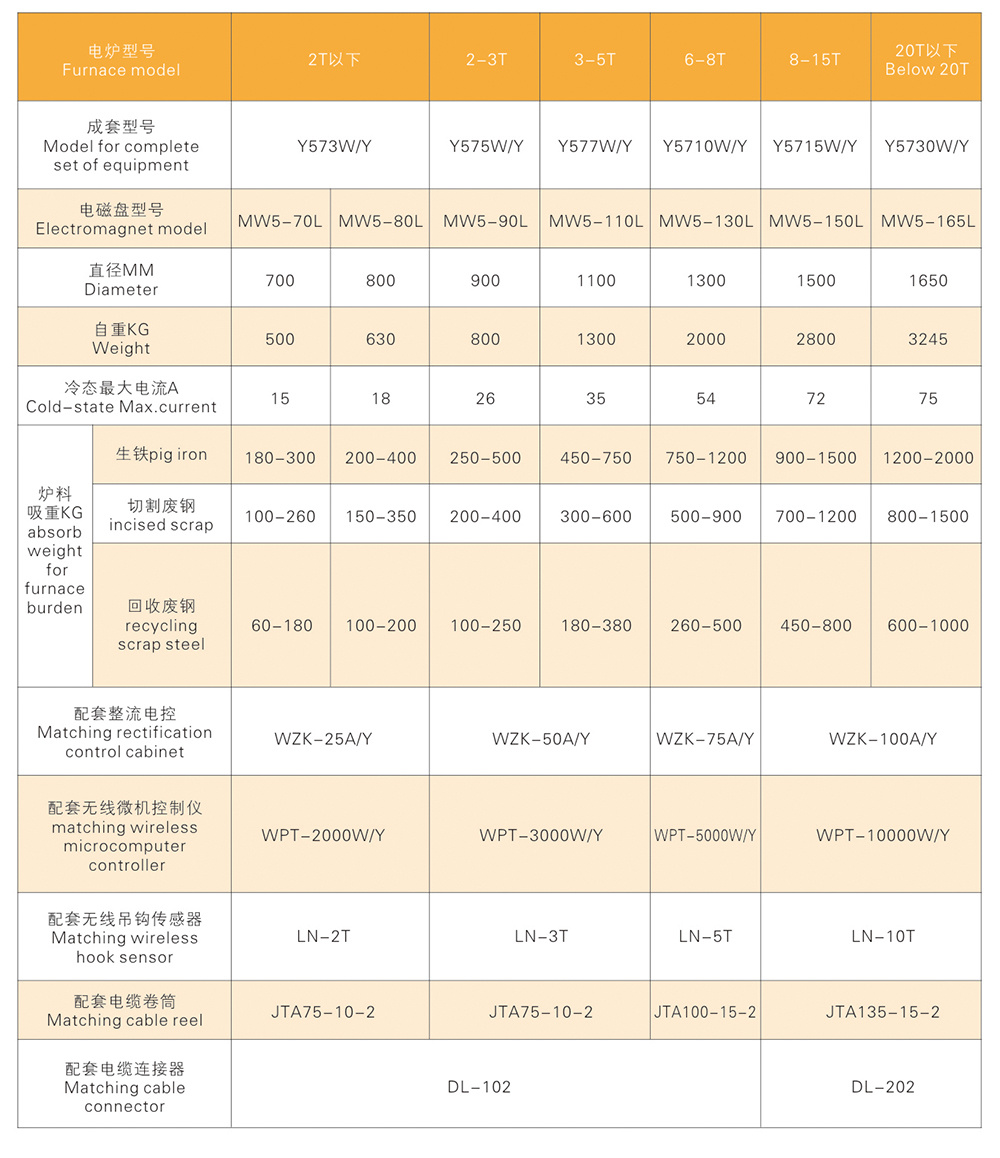
III. Monitoring Management System
A. Monitoring management software package:
Communicate with various subordinate machines (such as iron matching instruments, alloy batching instruments, spectrometers, thermal analyzers, temperature measuring instruments, large screens, etc.), send and receive data: send data such as formulas from each batching instrument, manage the uploaded data from each instrument, graphical analysis data, print statistical tables (such as grades, daily reports, weekly reports, monthly reports, annual reports, etc.), configure and display the working status of each device, set the main screen, real-time working status monitoring screen of the equipment, parameter setting and modification screen, data chart display management screen, batching calculation modification screen, alloy addition calculation screen, storage and printing management screen, electric furnace smelting analysis expert system.
B. Electric furnace batching monitoring integrated digital display screen:
Digital or dot matrix large screen, installed on the outer wall of the electric furnace platform control room, with clear visibility, displaying furnace number (vehicle number), unit number (batch number), material type number, batching set value, cumulative times, actual weight, cumulative weight, status of batching, alarm, standby, molten iron temperature, time, and can also display spectral analysis data, molten iron composition data, molten iron temperature, etc.
C. Batching crane automatic control system:
If it is a new project, and the user requires it, automatic control of the batching crane can be considered from the design stage, using Siemens PLC for automatic control of the batching crane, that is, the batching process is unmanned, based on the set formula and furnace number, the crane automatically controls the electromagnetic disk to feed the iron to the designated furnace material daily consumption pool, automatically weighs according to the formula, and then automatically places the prepared material into the charging vehicle, the entire process is fully automated, truly achieving complete automation of the batching process in the electric furnace.
D. Electric furnace molten iron weighing system:
Includes the overall weighing device of the electric furnace and the high-temperature hook scale weighing device for the molten iron bucket, which can display the weighing data of each furnace of molten iron and each bucket of molten iron on a large screen, and upload all weighing data to the upper computer, which is of great significance for measurement, raw materials, iron content, and process management.
E. Note: Generally, 2 to 4 furnaces can share a centralized control PLC cabinet: every two electric furnaces share one on-site operation platform: the electric control of the charging vehicle can choose either ordinary or variable frequency drive; the dimensions and weight of the charging vehicle are for reference only and need to be adjusted according to the specific situation of the electric furnace, especially the length needs to be related to the length from the center of the electric furnace to the edge of the electric furnace platform; the shape of the material drop opening of the vehicle needs to be determined according to the structure size of the electric furnace cover and dust removal system.
F. Upper computer monitoring management and display system:
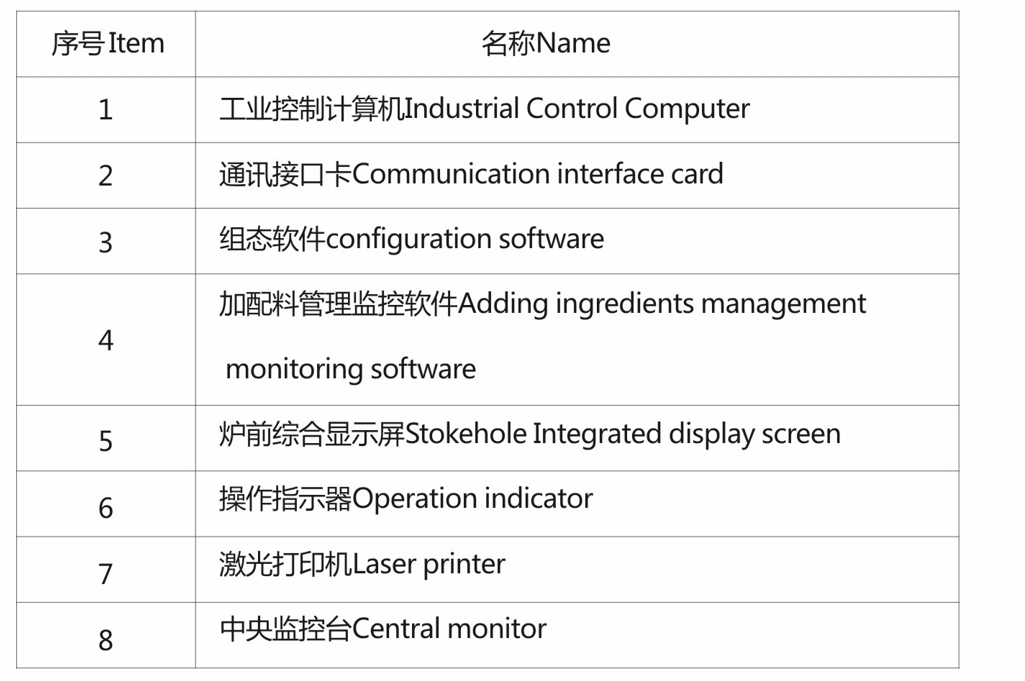
Note: The batching management monitoring software includes batching, management monitoring, and spectral analyzers, molten iron analyzers, molten iron temperature instruments, electric furnace weighing devices, and steel molten bucket weighing online management. An additional quotation will be provided for the automatic control system of the charging crane as per customer requirements.
Four, product illustration of the electric furnace batching system:
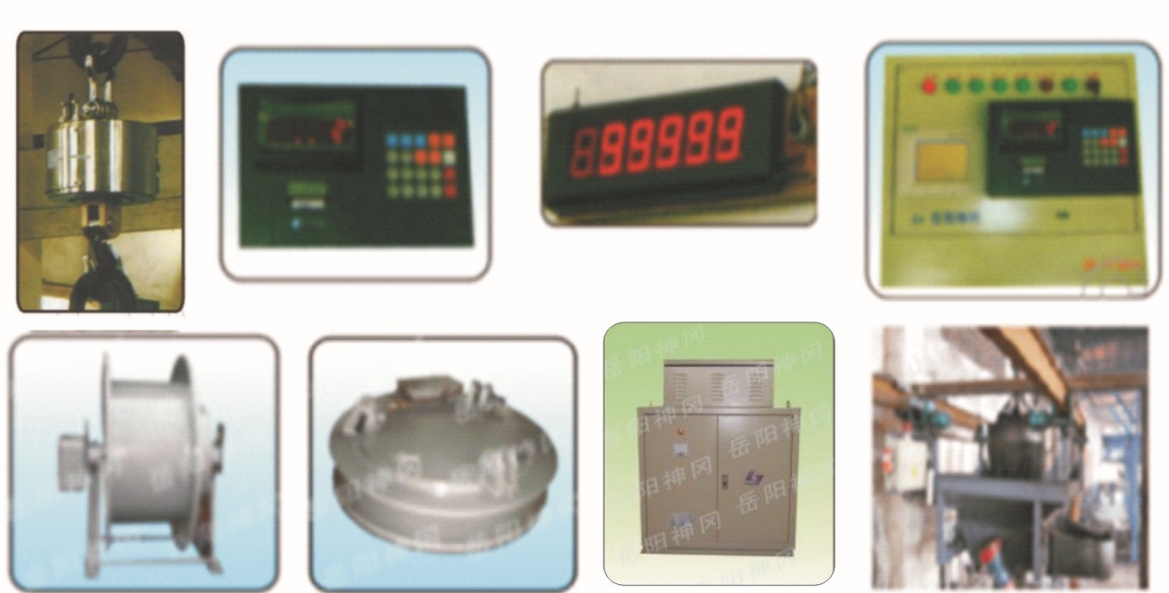
Key words:
Electromagnetic equipment manufacturing, multi-function lifting electromagnet, special lifting electromagnet, multi-purpose lifting electromagnet, permanent magnet coupling hysteresis head
Next Page
RELATED PRODUCTS
This series is used for absorbing and lifting cast iron ingots, steel balls, pig iron blocks, machined chips; return materials, iron concentrate powder, cutting heads; packaged scrap steel, etc. The excitation method can be: rated voltage DC220V method; strong excitation method: over-excitation method.
This series consists of oval-shaped lifting electromagnets, mainly used for efficiently loading and unloading scrap steel in narrow carriages. It can be customized according to the Size of the carriage.
This series is the most widely used rectangular electromagnet, mainly suitable for lifting square billets, steel ingots, and large initial rolled billets, and can also be used for lifting round billets, section steel, etc. Different magnetic circuit designs are adopted for different types of steel.
Online consultation
The company will continue to develop and innovate with the enterprise spirit of worrying about customers first and enjoying the happiness of customers later, and strive to become a giant of modern enterprises. Welcome all friends to visit and guide our company!
Address: Liji Avenue, Junshan Industrial Park, Yueyang City, Hunan Province
Fax: 0730-8647119




